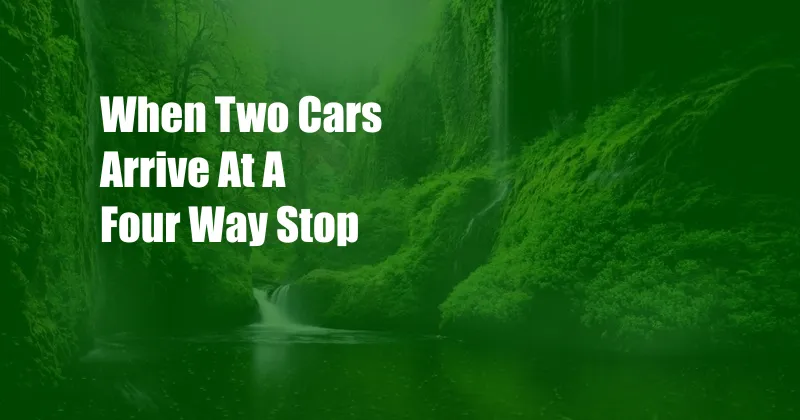
When Two Cars Arrive at a Four-Way Stop: Unraveling the Etiquette and Laws
Four-way stop junctions can be a breeding ground for uncertainty and even conflict among drivers. The seemingly simple task of determining who proceeds first can become a puzzling conundrum, leading to hesitation, frustration, and potential accidents.
To navigate these intersections with confidence and avoid any mishaps, it’s imperative to understand the established rules and customs governing them. This comprehensive guide will delve into the intricacies of four-way stop etiquette and legal requirements, providing you with the knowledge and guidance to approach these intersections with poise and clarity.
Yielding Precedence: A Matter of Courtesy and Safety
When two or more vehicles arrive at a four-way stop, the car that reaches the intersection first has the right of way. This principle is deeply ingrained in driving etiquette, ensuring an orderly flow of traffic.
However, this rule is not set in stone. Common courtesy dictates that drivers should yield to vehicles that are already in the intersection, regardless of who arrived first. This gesture of politeness not only avoids unnecessary delays but also reduces the risk of collisions.
The Legal Framework: Uncovering State Mandates
While yielding to the first-arriving vehicle is generally accepted practice, some states have codified this rule into law. For instance, in California, the Vehicle Code (CVC 22450) explicitly states that “the driver of a vehicle approaching a stop sign shall stop at a limit line, if marked, otherwise at the stop line, before entering the crosswalk on the near side of the intersection. The driver shall yield the right-of-way to vehicles that have entered the intersection from another highway or that are approaching so closely on the highway as to constitute an immediate hazard.”
Similarly, in New York, the Vehicle and Traffic Law (VTL 1142) stipulates that “every driver of a motor vehicle approaching an intersection where a stop sign is erected shall stop such vehicle before entering the crosswalk on the near side of the intersection or, if none, then at the point nearest the intersecting roadway where such driver has a view of approaching traffic on the intersecting roadway.”
Special Circumstances: Exceptions to the Rule
While yielding to the first-arriving vehicle is the general rule, there are a few exceptions to consider:
- Emergency vehicles: Emergency vehicles, such as ambulances, fire trucks, and police cars, always have the right of way, regardless of who arrived at the intersection first.
- Pedestrians: Pedestrians crossing the street also have the right of way. Drivers must yield to pedestrians who are in the crosswalk or about to enter it.
- Blocked intersections: If the intersection is blocked by traffic or a disabled vehicle, drivers may proceed with caution after ensuring that it is safe to do so.
- Multiple vehicles arriving simultaneously: If two or more vehicles arrive at the intersection at the same time, drivers should communicate with each other using hand gestures or eye contact to determine who will proceed first.
Expert Advice: Navigating Four-Way Stops with Confidence
In addition to understanding the rules and yielding to the first-arriving vehicle, practicing good driving habits can further enhance your experience at four-way stops:
- Approach the intersection cautiously: Slow down and be prepared to stop, even if you have the right of way.
- Make eye contact with other drivers: This simple gesture can help establish communication and prevent misunderstandings.
- Use hand gestures: If necessary, use hand gestures to indicate your intentions to other drivers.
- Be patient and courteous: Remember that other drivers may not be aware of the rules or may be hesitant. Be patient and give them the benefit of the doubt.
- Avoid distractions: Put away your phone and other distractions to focus on your driving.
Frequently Asked Questions: Answering Your Burning Questions
Q: What should I do if another driver doesn’t yield to me at a four-way stop?
A: Remain calm and do not try to force your way through the intersection. Instead, proceed with caution once it is safe to do so.
Q: Can I turn left at a four-way stop without stopping?
A: No. It is illegal to turn left at a four-way stop without first coming to a complete stop.
Q: What is the best way to handle multiple vehicles arriving at a four-way stop at the same time?
A: The driver who makes eye contact with the other drivers first should proceed first. If no one makes eye contact, the vehicle on the right should proceed first.
Q: What should I do if I’m driving a large vehicle, such as a truck or bus, at a four-way stop?
A: Large vehicles should be especially cautious at four-way stops due to their size and limited visibility. Yield to all other vehicles, even if you have the right of way.
Conclusion: A Call to Courteous and Informed Driving
Mastering the etiquette and laws surrounding four-way stops is not merely a matter of navigating intersections efficiently; it’s about promoting a culture of courtesy and safety on our roads. By understanding the rules, yielding to others, and practicing good driving habits, we can create a more harmonious and accident-free driving environment.
Are you interested in learning more about the intricacies of four-way stops? Join the conversation and share your experiences and insights in the comments section below.